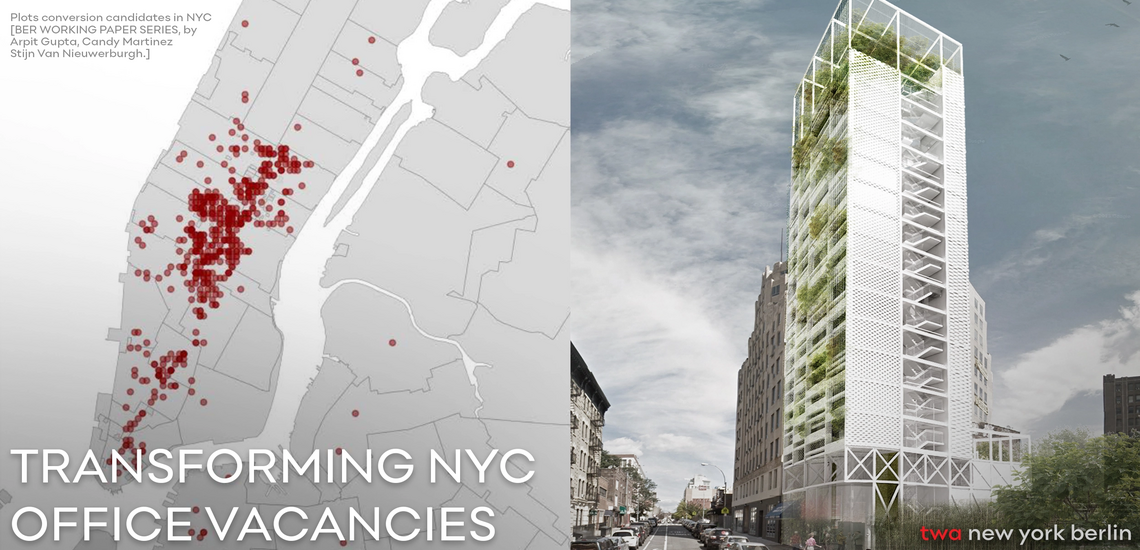In the ever-evolving landscape of New York City, the issue of office vacancies has taken center stage. As the city continues to adapt to changing demands and economic shifts, a compelling avenue emerges – the conversion of office spaces into residential units. This transformative approach not only presents opportunities for urban rejuvenation but also sparks meaningful discussions among policymakers and industry stakeholders.
The Landscape of Office Vacancies: Pros and Cons of Conversion
Office conversions, particularly those involving expansive floor plates, have gained traction as a potential solution to the growing concern about empty office spaces. However, these conversions are accompanied by a range of challenges. The intricacies of building codes, such as the requirement for natural light and ventilation for every habitable room, contribute to the substantial costs associated with these transformations. Despite the promising vision of repurposing office spaces, the feasibility of such conversions is often compromised by the exorbitant expenses they entail.
Some voices have urged lawmakers to consider the implications of demanding low-income units and union labor in office conversions. While well-intentioned, these demands add further complexity and expense to projects already grappling with financial hurdles. Striking a balance between revitalizing urban landscapes and maintaining economic viability is a delicate task that necessitates careful deliberation.
Unlocking Potential: The Environmental and Housing Benefits
On a brighter note, research authored by economists Arpit Gupta and Stijn Van Nieuwerburgh, and Candy Martinez has unveiled the environmental advantages of converting office buildings into residential spaces. The study reveals that these conversions could result in a 50-75% reduction in carbon emissions compared to new construction, contributing to the city's sustainability goals. Conversions of offices to sustainable apartments could preserve asset value while creating a residential housing supply and addressing climate change.
From a housing perspective, the potential impact is staggering. The ability to transform 10 to 15 percent of office space into residential units could generate over 40,000 housing units in New York City alone. These conversions align with the city's efforts to address its housing shortage and create vibrant, livable communities. By transforming former 9-to-5 office neighborhoods into mixed-use zones, these conversions inject life into streets, restaurants, and cultural facilities well beyond working hours, creating vibrant and engaging urban centers.
According to the paper, the typical conversion is financially feasible in dense, urban areas like New York, San Francisco, San Jose, Boston, Washington D.C., and Denver. These are markets where apartment rents are high enough to overcome the purchase cost of the office building and the cost of conversion.
Plotted points correspond to the number of conversion suitable buildings per MSA, nationally. [PHOTO: NBER WORKING PAPER SERIES, by Arpit Gupta Candy Martinez Stijn Van Nieuwerburgh.]
A New Chapter for 55 Broad Street: An Office-to-Residential Conversion
A quiet transformation is underway in Downtown Manhattan as 55 Broad Street prepares to shift from office space to apartments. Silverstein Properties and Metro Loft Management have successfully acquired the building from the Rudin family, making it one of the largest office-to-residential conversions in New York.
Navigating through financial intricacies, the developers secured the acquisition at $172.5M. The project's financing was supported by Banco Inbursa. The 30-story, 410,000-square-foot structure will be converted into 571 market-rate apartments.
Conversion of 55 Broad St. to apartments comes as office vacancies soar. [PHOTO: SILVERSTEIN PROPERTIES.]
The building's unique design features, including setbacks, have inspired a versatile range of apartment sizes and layouts, ranging from efficient units to loft-like layouts with generous terraces. The property will also offer diverse layouts from studios to three-bedroom apartments, and amenities like a private club, fitness center, elegant co-working space, and a rooftop pool with a sundeck and BBQ area.
The developers prioritize sustainability for this project by utilizing eco-friendly materials and aiming for LEED certification. This adaptive reuse approach reclaims carbon-intensive materials, resulting in a projected 22% lower energy usage compared to the current office building.
As construction gears up to commence next month, the project remains resilient despite legal challenges. Solstice Residential Group, an office tenant, has expressed concerns through a lawsuit, yet Metro Loft and Silverstein remain committed to their vision, aiming to complete the transformation within approximately two years.
Architecting the Future: Our Role in Office Conversions
Amid this dynamic urban landscape, TWA is facilitating the transition from vacant office spaces to thriving residential havens. We understand the intricate nuances of office-to-residential conversions and are equipped to collaborate with clients who are actively seeking to reshape the city's internal programming.
Whether working with real estate developers eyeing office towers for transformation or other stakeholders invested in repurposing urban spaces, we offer a comprehensive suite of services. From site analysis and feasibility studies to zoning and building code assessments, our expertise ensures a seamless conversion process. We are committed to generating innovative floor plate layouts that maximize space utilization and enhance the appeal of these transformed environments.
As New York City navigates the path to urban rejuvenation, TWA stands as a dedicated partner, poised to contribute to the city's transformation. We welcome inquiries of all forms related to these transformative endeavors and are excited to embark on this journey toward a more sustainable and vibrant urban future.
Office conversion on West 28th St and Broadway, Midtown Manhattan. Currently under construction. Designed by TWA.
